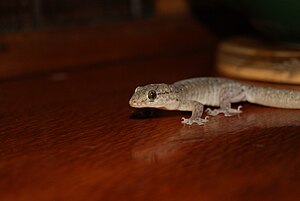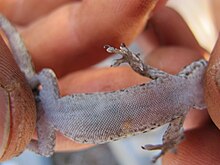Gehyra variegata
| Gehyra variegata | ||||||||||||
|---|---|---|---|---|---|---|---|---|---|---|---|---|

Gehyra variegata |
||||||||||||
| Systematics | ||||||||||||
|
||||||||||||
| Scientific name | ||||||||||||
| Gehyra variegata | ||||||||||||
| ( Duméril & Bibron , 1836) |
Gehyra variegata belongs to the gecko family and is found exclusively on mainland Australia .
Origin and Distribution
The origin of the genus Gehyra is disputed. It probably originates from Melanesia and not from Gondwana like most of the other genera in the gecko family. Today it is found widespread throughout mainland Australia , except in some areas in the north-west and south-east. Field studies have shown that there are metapopulations within different geographic regions.
habitat
They live in dry to semi-humid areas in trees (arboreal) or between stones (saxicol). They are often found under loose pieces of bark, in holes in trees, on dying logs, in crevices in the earth or between stones.
They have the ability to survive even in small areas of land that are heavily influenced by humans, as they can adapt their habitat to changed environmental conditions. For example, populations in the nature reserve live in eucalyptus , compared to populations in agricultural habitats, which live more in dead tree trunks.
features
The head-trunk length of an adult Gehyra variegata is between 50 mm and 55 mm. The color varies from gray to dark brown. The pattern, which runs like a net over the entire surface of the body, ranges from checkered to white to light brown dotted to marbled. Only two or three darker lines always run from the muzzle to the neck.
They have five toes on each foot, and all but the innermost toes have claws. Large cushions with slats ensure good adhesion, so that they can also move easily when overhanging, as is generally known from geckos.
Way of life
Like all reptiles, Gehyra variegata belongs to the cold-blooded animals . They belong to the group that depend on the heat exchange to the substrate . The saxicol living individuals get their warmth from the stones between which they hide. The arboreal individuals get their warmth from the bark warmed by the sun. They change their position under the bark to match the position of the sun. This behavior is probably related to the high temperatures that are used for digestion.
When attacked, they can throw off their tail to confuse their opponent. This then moves on for a few minutes, giving the animal the opportunity to flee. The tail grows back later, but usually not as long as before. Another special feature is the shrill scream, which also serves as a defense mechanism.
food
The diet consists mainly of beetles , termites , grasshoppers , cockroaches and spiders . They hunt mainly during twilight and stay within a ten meter radius of their territory .
Reproduction
Life expectancy is around five years. The sexual maturity is reached after the age of three. Males are territorial , with several females sharing the habitat with one male.
Gehyra variegata is oviparous . The eggs are hard-shelled and are protected under bark, old tree trunks or in holes between stones. The clutch consists of a single egg. The storage areas are often used jointly, and clutches of up to 35 eggs have already been observed. Eggs are laid twice with an interval of one month during the breeding season. The first hard-shelled egg (~ 10 mm) is laid at the end of November. After about two months (~ 61 to 79 days) the young hatch, which are already around 45 mm long.
Individual evidence
- ↑ a b c Michael, D., Lindenmayer, D. (2010). Reptiles of the NSW Murray Catchment: A Guide to Their Identification, Ecology and Conservation. Collingwood: CSIRO Publishing
- ↑ M. Sistrom, M. Hutchinson, T. Bertozzi, S. Donnellan: Evaluating evolutionary history in the face of high gene tree discordance in Australian Gehyra (Reptilia: Gekkonidae) . In: Heredity . tape 113 , no. 1 , July 1, 2014, ISSN 0018-067X , p. 52–63 , doi : 10.1038 / hdy.2014.6 ( nature.com [accessed April 5, 2016]).
- ↑ Paul M. Oliver, Kate L. Sanders: Molecular evidence for Gondwanan origins of multiple lineages within a diverse Australasian gecko radiation. In: Journal of Biogeography . tape 36 , no. 11 , November 1, 2009, ISSN 1365-2699 , p. 2044–2055 , doi : 10.1111 / j.1365-2699.2009.02149.x ( wiley.com [accessed April 5, 2016]).
- ↑ a b c Swan, G. (1990). A Field Guide to the Snakes and Lizards of New South Wales. Winmalee: Three Sisters Productions, Pty Ltd
- ^ Wilson, S., Swan, G. (2003). A Complete Guide to Reptiles of Australia. Sydney: Reed New Holland
- ↑ a b c Mallee CMA (ed.): Mallee Lizzards Fieldguide. 2013, ISBN 978-1-920777-26-5 .
- ↑ Michael Swan and Simon Watharow: Snakes, Lizzards and Frogs of the Vitorian Mallee. Ed .: Royal Melbourne Zoo. 2005, ISBN 978-0-643-09134-4 .
- ^ A b Harold G. Cogger : Reptiles & Amphibians of Australia. 7th edition. CSIRO Publishing, Collingwood 2014, ISBN 978-0-64310035-0 .
- ^ Heatwole, HF, Taylor, J. (1987). Ecology of Reptiles. Chipping Norton: Surrey Beatty & Sons Pty Ltd.
- ↑ a b Cronin, L. (2001). Australian Reptiles and Amphibians: Key Guide. Annandale: Envirobook
Web links
- Gehyra variegata in The Reptile Database ; accessed on April 15, 2016.
- Max King, Paul Horner, Fauna of Australia, 37. Family of Gekkonidae Online

